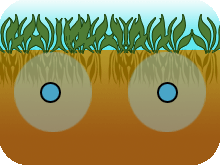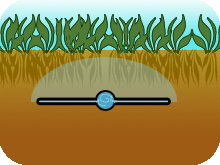
This mailer has been provided as an avenue to disperse information pertinent to public agencies and the landscape architecture profession in hopes of fostering greater understanding and collaboration. Topics address issues that affect the built environment within which we live.
Subsurface Irrigation Methods
"There is no small pleasure in sweet water", Ovid (Publius Ovidius Naso)
As our society becomes more aware of and continues to value sustainable practices in land development, water never fails to be one of the most popular topics of discussion. With "sustainable" or "wise" use of water in mind, this edition of LAND Connections will summarize a few of the most efficient methods of landscape irrigation available today.
In-Line Drip Systems
There are many types of tubing and emitters available for sub-surface irrigation applications. Most of them use traditional irrigation methods for water transportation (i.e. pressurized water lines and distribution tubing). The water is then dispersed through properly spaced subsurface emitters. The most common installations involve rows or grids of in-line tubing designed to provide even distribution of water which is installed just below the soil surface. Additional equipment for system flushing and release of trapped air is also required.
Pros: Relatively low cost, direct root zone water application, vandal resistance, reduction in surface molds and mildews, low water flows & limited water loss from evaporation.
Cons: Plugging of emitters, lack of visibility, vulnerable to damage when digging in or aerating soil, gravitational loss of water before plant use.
Wicking Systems
A relatively new irrigation method on the market combines traditional drip methods of water transportation with the soils natural ability to move water, capillary action. This system consists of distribution tubing with emitters, a water dispersing layer, a capillary fiber mat and an anti-percolation layer to discourage loss of water due to gravitational forces. This dispersal layer and capillary fiber mat "wick" the moisture from the distribution tubing and emitters creating a synergistic network containing millions of "mini" emitters. The soils natural ability to wick the soil then disperses the water throughout the rest of the plant root zone. The anti-percolation layer is vital to the success of the system as it allows water to travel through the capillary fiber mat laterally and vertically before gravitational forces pull it out of the active root growth zone.
Pros: Fairly low installation and material costs, direct root zone water application, vandal resistance, reduction in surface molds and mildews, low water flows, wide tubing spacing, minimal gravitational water loss & limited water loss from evaporation.
Cons: Requires an experienced contractor to install, plugging of emitters, crushing of tubing due to heavy loads, lack of visibility, vulnerable to damage when digging in or aerating soils.
Water Collection & Storage Systems
Another relatively new irrigation method on the market combines stormwater management techniques and the soils natural ability to move water, capillary action, to irrigate the landscape. This system consists of a subsurface liner or plastic bin, an integrated storage chamber, a chamber connection system and washed sand. This system requires that all plantings be installed within an engineered sand bed because of its ability to move water via capillary action. After unused stormwater percolates through the sand mixture it is captured in the storage chamber and is released back into the soil via capillary action as the plants require it. The key to this system is keeping water in the storage chamber for use at a later date. This is partially possible because of the liner and bins which eliminate loss of water into the natural soil profile. In arid areas however, additional water will need to be pumped into the storage chambers during months of low precipitation.
Pros: Direct root zone water application, water is used as needed resulting in no waste, gravitation water dispersal system, re-use of storm water, can be used in conjunction with septic systems, vandal resistance, reduction in surface molds and mildews, low water flows, limited water loss from evaporation & no electrical equipment.
Cons: Installation and material costs, requires additional water to fill chambers during low precipitation months, possible nutrient deficiency issues, lack of visibility, vulnerable to damage when digging in soils.
The summaries above are just a few of the efficient options that are available for irrigating urban landscapes in California. If you would like to know more about these irrigation methods or others, please feel free to contact me with questions.
The next time you need a Landscape Architect on your project, consider O'Dell Engineering's Landscape Architecture Department.
Services include:
- Park and Playground Design
- Recreational Facility Design
- Site Planning
- Streetscape Design
- Urban Design
- Commercial Design
- 3-D Visualizations
- Graphic Design
- Arborist Consulting
![]()
![]()




Author: Chad Kennedy, Landscape Architect
This informational article provided by O'Dell Engineering - 1165 Scenic Drive, Suite A, Modesto CA 95350
